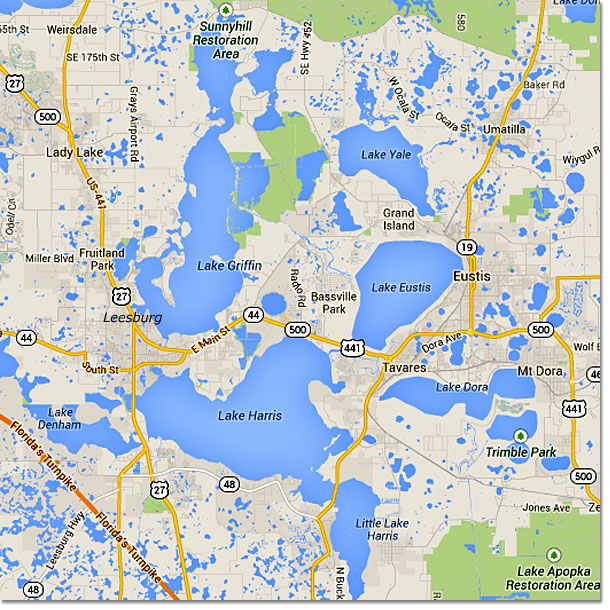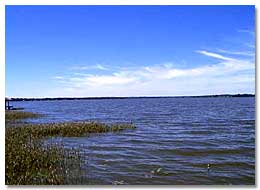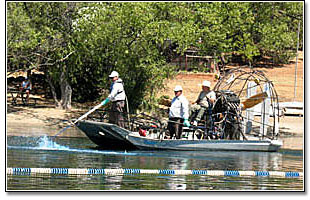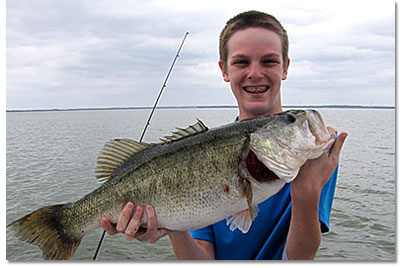
Harris Chain Bass Fishing Overview
The beautiful and scenic Harris Chain Lakes are located in Central Florida's Lake County about 40 minutes northwest of Orlando.
The interconnected lakes of the Harris Chain cover approximately 50,000 acres of water and together make up the second largest lake
in the State of Florida. The Harris Chain is part of the
Ocklawaha River basin, a main tributary of the St. John's River
which drains North Central Florida and exits into the Atlantic Ocean at Jacksonville. A number
of small cities and numerous waterfront homes surround the lake
making lakefront activities, fishing and boating a favorite activity
with locals and visitors alike. Read more...

The Harris Chain lakes are extremely fertile and contain a wide variety of water clarities and colors.
The primary cover is Kissimmee grass, eel grass, pepper grass, lily pads, reeds and cattails. The clearest water is in the canals and
spring areas. The water color in the main lake is stained
with limited visibility, especially in the summer months
when algae blooms are most common. Algae blooms are only a few inches thick with the underlying water color being a light green. In
recent years, the water clarity of the lakes has greatly improved as
water officials allowed lake levels to fluctuate naturally with
annual rainfall. Flushing in high water and wind action during drought sweeps the shoreline and allows native grasses to re-grow.
 The center depth of the lakes is about 10-12 feet on
average with no reefs or open lake obstacles to impede navigation. Big Lake Harris has the deepest water at about 30 feet along the
south shoreline. Lake Griffin is the shallowest and has the least amount of development. Water depth in the numerous canals
surrounding the lake varies considerably. It is not uncommon to see dry land in many of these canals during extended droughts. The
deepest Harris Chain canals are in Astatula within the development of Lake Harris Shores. Nine of the Harris Chain lakes are
interconnected via navigable canals and waterways. Lake Yale is landlocked and Lake Apopka is connected by the Apopka/Beauclair
canal and lock. The center Lake in the Chain is Lake Eustis. Lake Griffin has two locks, one on Haines Creek
leading into Lake Eustis and the other at the top of the lake at Moss Bluff. Through the Moss Bluff lock you can travel by boat past
Silver Springs to Jacksonville where the St. Johns River meets the Atlantic. Lake Dora, Beauclair and Carlton are the east Harris Chain
lakes and can be accessed from Lake Eustis via the picturesque Dora Canal. Lake Harris and Lake Eustis are connected by the wide Dead
River waterway. There are a number of boater friendly restaurants on the Harris Chain. The Hurricane Dockside Grill is a
popular waterfront destination on the Dead River. The downtown Eustis City docks provide boater access to the downtown area just a
short walk away. The popular Al's Landing Restaurant and the Tavares Sea Plane base are located on Lake Dora. Mount Dora has a public
dock at Gilbert Park, with historic downtown Mount Dora nearby. The Lake Harris Hideaway Restaurant has gone through a number of name
changes through the years, but remains very popular with boaters and weekend biker cruisers.
The center depth of the lakes is about 10-12 feet on
average with no reefs or open lake obstacles to impede navigation. Big Lake Harris has the deepest water at about 30 feet along the
south shoreline. Lake Griffin is the shallowest and has the least amount of development. Water depth in the numerous canals
surrounding the lake varies considerably. It is not uncommon to see dry land in many of these canals during extended droughts. The
deepest Harris Chain canals are in Astatula within the development of Lake Harris Shores. Nine of the Harris Chain lakes are
interconnected via navigable canals and waterways. Lake Yale is landlocked and Lake Apopka is connected by the Apopka/Beauclair
canal and lock. The center Lake in the Chain is Lake Eustis. Lake Griffin has two locks, one on Haines Creek
leading into Lake Eustis and the other at the top of the lake at Moss Bluff. Through the Moss Bluff lock you can travel by boat past
Silver Springs to Jacksonville where the St. Johns River meets the Atlantic. Lake Dora, Beauclair and Carlton are the east Harris Chain
lakes and can be accessed from Lake Eustis via the picturesque Dora Canal. Lake Harris and Lake Eustis are connected by the wide Dead
River waterway. There are a number of boater friendly restaurants on the Harris Chain. The Hurricane Dockside Grill is a
popular waterfront destination on the Dead River. The downtown Eustis City docks provide boater access to the downtown area just a
short walk away. The popular Al's Landing Restaurant and the Tavares Sea Plane base are located on Lake Dora. Mount Dora has a public
dock at Gilbert Park, with historic downtown Mount Dora nearby. The Lake Harris Hideaway Restaurant has gone through a number of name
changes through the years, but remains very popular with boaters and weekend biker cruisers.
The Harris Chain's Decline of the 1990s
Forty years ago the Harris Chain hosted numerous national bass tournaments including the B.A.S.S. Megabucks. Around 1990, B.A.S.S. held a disastrous national
tournament on the Chain, setting a record for the lowest average catch rate of any national tournament. This tournament created
ripples throughout bass fishing circles, eventually culminating in the publishing of an article in the December 1992 issue of "Bassmaster
Magazine" detailing many of the problems. The causes for the decline
were reported as; over enthusiastic weed spraying, locks, pollution
from Lake Apopka, mysterious bass viruses and a dozen other causes.
Whatever the cause, it was clear that bass fishing in the Harris
Chain had significantly declined from previous levels.
 A major contributor to the decline in Harris
Chain bass fishing was the over application of herbicides and the introduction of grass carp into the lakes in the late eighties. By
1987, hydrilla had become a major problem in the chain. State and County water managers viewed this development as an alien attack and
made the decision to totally eradicate hydrilla from the chain. A new chemical tool, Sonar (fluridone) had just been developed that
promised to make short work of this invasive plant. Unfortunately, little was know about the long term effects of Sonar and proper
treatment levels had yet to be worked out. Empowered by the Florida Department of Environmental Protection's edict to "use any and all
methods to eradicate non-native evasive plants", County employees managed to kill
virtually all the hydrilla between 1987 and 1988.
Unfortunately, these massive treatments also had a devastating effect on native plant species as well. Huge fields of pads, pepper
and eel grass sank to the bottom of the lakes. By 1990 when the infamous B.A.S.S. tournament was held, the lakes were almost totally void of cover and traditional bass spawning areas were covered in dead plants and
debris. The few bass that were caught were caught in the back of the canals where chemicals failed to reach.
A major contributor to the decline in Harris
Chain bass fishing was the over application of herbicides and the introduction of grass carp into the lakes in the late eighties. By
1987, hydrilla had become a major problem in the chain. State and County water managers viewed this development as an alien attack and
made the decision to totally eradicate hydrilla from the chain. A new chemical tool, Sonar (fluridone) had just been developed that
promised to make short work of this invasive plant. Unfortunately, little was know about the long term effects of Sonar and proper
treatment levels had yet to be worked out. Empowered by the Florida Department of Environmental Protection's edict to "use any and all
methods to eradicate non-native evasive plants", County employees managed to kill
virtually all the hydrilla between 1987 and 1988.
Unfortunately, these massive treatments also had a devastating effect on native plant species as well. Huge fields of pads, pepper
and eel grass sank to the bottom of the lakes. By 1990 when the infamous B.A.S.S. tournament was held, the lakes were almost totally void of cover and traditional bass spawning areas were covered in dead plants and
debris. The few bass that were caught were caught in the back of the canals where chemicals failed to reach.
The Harris Chain Recovery
 Twenty years later, the lakes have largely recovered from the chemical purge. Most of the grass carp have died or have been
removed and our great bass fishing has returned. Much of the credit for the recovery has to be given to St. John's Water Water
Management who made the decision to let the lakes seek their own levels instead of artificially holding the lake water levels high.
Florida's natural cycle of high and low water allows shorelines to be naturally cleaned during droughts allowing bass
to return to newly invigorated spawning areas when the water returns. Recently, a significant attitude change seems to be taking place as
water managers attempt to manage hydrilla instead of concentrating their efforts on eradicating it entirely. Other reasons for
the recovery of the Harris Chain bass fishery can be identified. In the early nineties, Florida implemented a five bass 14" daily limit
that went a long way to improve the overall success of Florida bass anglers. Catch and release caught on with anglers and guides. During
droughts, game officials and local residents replanted acres of beneficial reeds in large areas of the Chain. A new water filtering
facility located at the mouth of Lake Beauclair is showing great
promise in cleaning the water flowing into the Chain from Lake
Apopka. The future of the Harris Chain bass fishery is bright and
baring the repeat of past mistakes, should continue to improve.
Twenty years later, the lakes have largely recovered from the chemical purge. Most of the grass carp have died or have been
removed and our great bass fishing has returned. Much of the credit for the recovery has to be given to St. John's Water Water
Management who made the decision to let the lakes seek their own levels instead of artificially holding the lake water levels high.
Florida's natural cycle of high and low water allows shorelines to be naturally cleaned during droughts allowing bass
to return to newly invigorated spawning areas when the water returns. Recently, a significant attitude change seems to be taking place as
water managers attempt to manage hydrilla instead of concentrating their efforts on eradicating it entirely. Other reasons for
the recovery of the Harris Chain bass fishery can be identified. In the early nineties, Florida implemented a five bass 14" daily limit
that went a long way to improve the overall success of Florida bass anglers. Catch and release caught on with anglers and guides. During
droughts, game officials and local residents replanted acres of beneficial reeds in large areas of the Chain. A new water filtering
facility located at the mouth of Lake Beauclair is showing great
promise in cleaning the water flowing into the Chain from Lake
Apopka. The future of the Harris Chain bass fishery is bright and
baring the repeat of past mistakes, should continue to improve.





 The center depth of the lakes is about 10-12 feet on
average with no reefs or open lake obstacles to impede navigation. Big Lake Harris has the deepest water at about 30 feet along the
south shoreline. Lake Griffin is the shallowest and has the least amount of development. Water depth in the numerous canals
surrounding the lake varies considerably. It is not uncommon to see dry land in many of these canals during extended droughts. The
deepest Harris Chain canals are in Astatula within the development of Lake Harris Shores. Nine of the Harris Chain lakes are
interconnected via navigable canals and waterways. Lake Yale is landlocked and Lake Apopka is connected by the Apopka/Beauclair
canal and lock. The center Lake in the Chain is Lake Eustis. Lake Griffin has two locks, one on Haines Creek
leading into Lake Eustis and the other at the top of the lake at Moss Bluff. Through the Moss Bluff lock you can travel by boat past
Silver Springs to Jacksonville where the St. Johns River meets the Atlantic. Lake Dora, Beauclair and Carlton are the east Harris Chain
lakes and can be accessed from Lake Eustis via the picturesque Dora Canal. Lake Harris and Lake Eustis are connected by the wide Dead
River waterway. There are a number of boater friendly restaurants on the Harris Chain. The Hurricane Dockside Grill is a
popular waterfront destination on the Dead River. The downtown Eustis City docks provide boater access to the downtown area just a
short walk away. The popular Al's Landing Restaurant and the Tavares Sea Plane base are located on Lake Dora. Mount Dora has a public
dock at Gilbert Park, with historic downtown Mount Dora nearby. The Lake Harris Hideaway Restaurant has gone through a number of name
changes through the years, but remains very popular with boaters and weekend biker cruisers.
The center depth of the lakes is about 10-12 feet on
average with no reefs or open lake obstacles to impede navigation. Big Lake Harris has the deepest water at about 30 feet along the
south shoreline. Lake Griffin is the shallowest and has the least amount of development. Water depth in the numerous canals
surrounding the lake varies considerably. It is not uncommon to see dry land in many of these canals during extended droughts. The
deepest Harris Chain canals are in Astatula within the development of Lake Harris Shores. Nine of the Harris Chain lakes are
interconnected via navigable canals and waterways. Lake Yale is landlocked and Lake Apopka is connected by the Apopka/Beauclair
canal and lock. The center Lake in the Chain is Lake Eustis. Lake Griffin has two locks, one on Haines Creek
leading into Lake Eustis and the other at the top of the lake at Moss Bluff. Through the Moss Bluff lock you can travel by boat past
Silver Springs to Jacksonville where the St. Johns River meets the Atlantic. Lake Dora, Beauclair and Carlton are the east Harris Chain
lakes and can be accessed from Lake Eustis via the picturesque Dora Canal. Lake Harris and Lake Eustis are connected by the wide Dead
River waterway. There are a number of boater friendly restaurants on the Harris Chain. The Hurricane Dockside Grill is a
popular waterfront destination on the Dead River. The downtown Eustis City docks provide boater access to the downtown area just a
short walk away. The popular Al's Landing Restaurant and the Tavares Sea Plane base are located on Lake Dora. Mount Dora has a public
dock at Gilbert Park, with historic downtown Mount Dora nearby. The Lake Harris Hideaway Restaurant has gone through a number of name
changes through the years, but remains very popular with boaters and weekend biker cruisers. A major contributor to the decline in Harris
Chain bass fishing was the over application of herbicides and the introduction of grass carp into the lakes in the late eighties. By
1987, hydrilla had become a major problem in the chain. State and County water managers viewed this development as an alien attack and
made the decision to totally eradicate hydrilla from the chain. A new chemical tool, Sonar (fluridone) had just been developed that
promised to make short work of this invasive plant. Unfortunately, little was know about the long term effects of Sonar and proper
treatment levels had yet to be worked out. Empowered by the Florida Department of Environmental Protection's edict to "use any and all
methods to eradicate non-native evasive plants", County employees managed to kill
virtually all the hydrilla between 1987 and 1988.
Unfortunately, these massive treatments also had a devastating effect on native plant species as well. Huge fields of pads, pepper
and eel grass sank to the bottom of the lakes. By 1990 when the infamous B.A.S.S. tournament was held, the lakes were almost totally void of cover and traditional bass spawning areas were covered in dead plants and
debris. The few bass that were caught were caught in the back of the canals where chemicals failed to reach.
A major contributor to the decline in Harris
Chain bass fishing was the over application of herbicides and the introduction of grass carp into the lakes in the late eighties. By
1987, hydrilla had become a major problem in the chain. State and County water managers viewed this development as an alien attack and
made the decision to totally eradicate hydrilla from the chain. A new chemical tool, Sonar (fluridone) had just been developed that
promised to make short work of this invasive plant. Unfortunately, little was know about the long term effects of Sonar and proper
treatment levels had yet to be worked out. Empowered by the Florida Department of Environmental Protection's edict to "use any and all
methods to eradicate non-native evasive plants", County employees managed to kill
virtually all the hydrilla between 1987 and 1988.
Unfortunately, these massive treatments also had a devastating effect on native plant species as well. Huge fields of pads, pepper
and eel grass sank to the bottom of the lakes. By 1990 when the infamous B.A.S.S. tournament was held, the lakes were almost totally void of cover and traditional bass spawning areas were covered in dead plants and
debris. The few bass that were caught were caught in the back of the canals where chemicals failed to reach. Twenty years later, the lakes have largely recovered from the chemical purge. Most of the grass carp have died or have been
removed and our great bass fishing has returned. Much of the credit for the recovery has to be given to St. John's Water Water
Management who made the decision to let the lakes seek their own levels instead of artificially holding the lake water levels high.
Florida's natural cycle of high and low water allows shorelines to be naturally cleaned during droughts allowing bass
to return to newly invigorated spawning areas when the water returns. Recently, a significant attitude change seems to be taking place as
water managers attempt to manage hydrilla instead of concentrating their efforts on eradicating it entirely. Other reasons for
the recovery of the Harris Chain bass fishery can be identified. In the early nineties, Florida implemented a five bass 14" daily limit
that went a long way to improve the overall success of Florida bass anglers. Catch and release caught on with anglers and guides. During
droughts, game officials and local residents replanted acres of beneficial reeds in large areas of the Chain. A new water filtering
facility located at the mouth of Lake Beauclair is showing great
promise in cleaning the water flowing into the Chain from Lake
Apopka. The future of the Harris Chain bass fishery is bright and
baring the repeat of past mistakes, should continue to improve.
Twenty years later, the lakes have largely recovered from the chemical purge. Most of the grass carp have died or have been
removed and our great bass fishing has returned. Much of the credit for the recovery has to be given to St. John's Water Water
Management who made the decision to let the lakes seek their own levels instead of artificially holding the lake water levels high.
Florida's natural cycle of high and low water allows shorelines to be naturally cleaned during droughts allowing bass
to return to newly invigorated spawning areas when the water returns. Recently, a significant attitude change seems to be taking place as
water managers attempt to manage hydrilla instead of concentrating their efforts on eradicating it entirely. Other reasons for
the recovery of the Harris Chain bass fishery can be identified. In the early nineties, Florida implemented a five bass 14" daily limit
that went a long way to improve the overall success of Florida bass anglers. Catch and release caught on with anglers and guides. During
droughts, game officials and local residents replanted acres of beneficial reeds in large areas of the Chain. A new water filtering
facility located at the mouth of Lake Beauclair is showing great
promise in cleaning the water flowing into the Chain from Lake
Apopka. The future of the Harris Chain bass fishery is bright and
baring the repeat of past mistakes, should continue to improve.